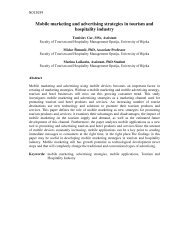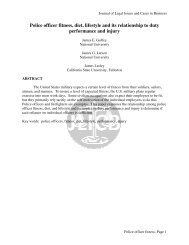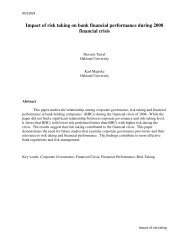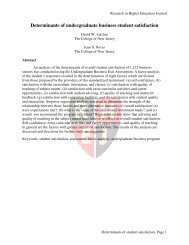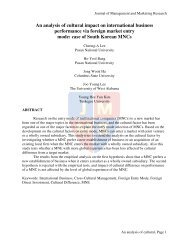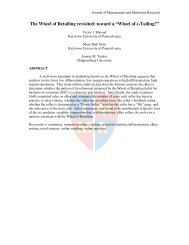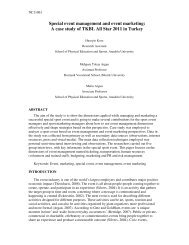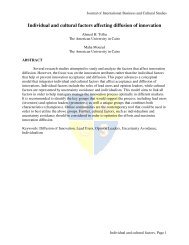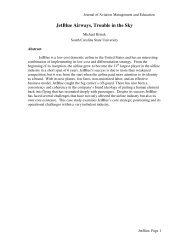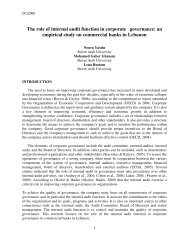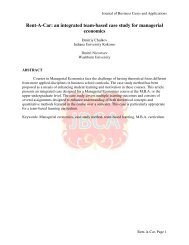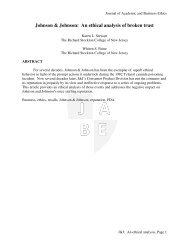Need-Based Segmentation Analysis of University Career Services ...
Need-Based Segmentation Analysis of University Career Services ...
Need-Based Segmentation Analysis of University Career Services ...
Create successful ePaper yourself
Turn your PDF publications into a flip-book with our unique Google optimized e-Paper software.
Research In Higher Education Journal<br />
In this section, implications are discussed for universities trying to increase participation<br />
in career services. We describe ways in which knowledge <strong>of</strong> the four major student segment<br />
needs can be used to more effectively market to them. The marketing strategies we recommend<br />
are intended to raise career services participation rates within each segment. In the remainder <strong>of</strong><br />
this section, segment preferences are summarized followed by recruiting and communication<br />
strategies that are put forth for each segment.<br />
Placements<br />
Placements desire a large number <strong>of</strong> interviews with good companies (see Table 3).<br />
Hence, placements may believe that they know what they want and need in order to transition<br />
from the academy to the working world. Following qualitative research by McCorkle et al.<br />
(2003, p. 202) on marketing students, this “perception needs correction as most campus career<br />
services can provide far more than the desired on-campus job interviews, such as company<br />
research sources <strong>of</strong> information; mock interviewing; and skill development seminars on<br />
résumé/cover letter writing, job interviews, and other job search techniques.”<br />
Business students are disproportionately more likely than other students to be placements<br />
(42.9 %) and the vast majority <strong>of</strong> this segment has had one or more internship experiences. An<br />
analysis <strong>of</strong> the data (see table 4) reveals that placements see themselves as more career oriented<br />
and heavy users <strong>of</strong> career services. Behavioral data from our focal UCSC provides support for<br />
this conclusion.<br />
In general, undergraduates tend to prefer time-limited career assistance (Shivy & Koehly,<br />
2002). This may be particularly true for placements (see Table 3) that place far less importance<br />
on: (1) getting help with job search strategies (4.3), (2) taking assessment tests (0.9), (3)<br />
participating in mock interviews (0.7) and (4) having their resume critiqued (1.7).<br />
<strong>Based</strong> on our understanding <strong>of</strong> the needs and preferences <strong>of</strong> placements, they will likely<br />
be responsive to appeals that <strong>of</strong>fer students assistance in developing networking strategies (Shivy<br />
& Koehly, 2002). Simply put, placements may need help building sufficient networks <strong>of</strong> support<br />
(Brown & Krane, 2000). Thus, appeals should focus more on networking-related benefits.<br />
Placements Strategy: Promote Networking Opportunities<br />
There is evidence to support the notion that the philosophical orientation <strong>of</strong> UCSCs has<br />
shifted from “placement” toward networking (Baker, 1998; Casella, 1990; Wessel, 1996).<br />
Networking, a non-traditional type <strong>of</strong> mentoring, has been suggested as a replacement for the<br />
traditional model <strong>of</strong> dyadic mentoring (Packard, 2003). Networking has been called the most<br />
powerful vehicle in making the transition from the academy to the work force (Casella, 1990;<br />
Wessel, 1996). Indeed, more than 30 percent <strong>of</strong> the respondents in a recent survey <strong>of</strong> UCSC<br />
directors stated that the rationale for their department’s existence was “connecting students with<br />
employers” (Wessel, 1996). As indicated by Peterson (1995), as much as 80% <strong>of</strong> all jobs are<br />
obtained through personal contacts. The ultimate goal for UCSCs should be to foster an<br />
independent networking orientation in these students (Scott, 1983).<br />
According to Brooks (1996), a networking orientation can be accomplished in at least<br />
three important ways. First, the UCSC should forge links between faculty and potential<br />
employers. Second, the UCSC should engage in on-campus college relations activities (e.g.,<br />
<strong>of</strong>fering company information sessions). Third, the UCSC should <strong>of</strong>fer and promote <strong>of</strong>f-campus<br />
<strong>Need</strong>s-<strong>Based</strong> <strong>Segmentation</strong> <strong>Analysis</strong>, Page 11



